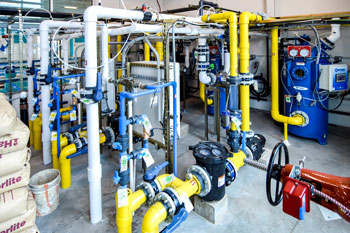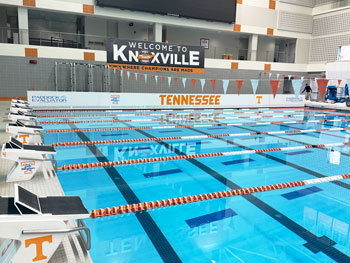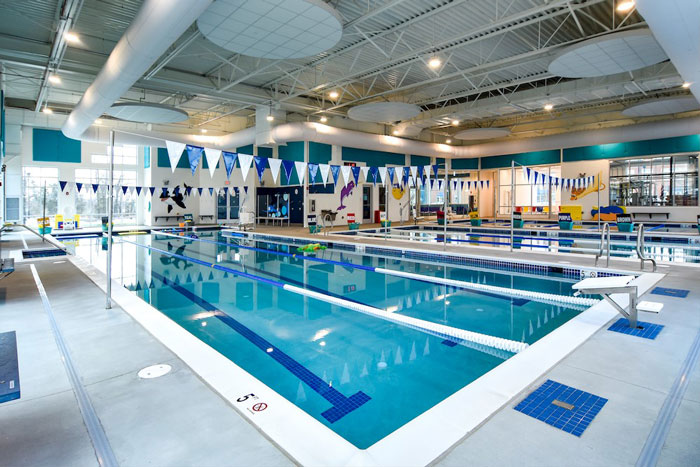Most visitors to indoor pools have a few seemingly simple requirements, including clean, clear water and good air quality. And while these factors seem fundamental, for those who operate and maintain indoor pools they present a never-ending challenge involving science, technology, up-to-date equipment and vigilant maintenance procedures, which are all essential to ensure the safety and health of swimmers and staff.
Dewey Case is the technical director at the nonprofit Council for the Model Aquatic Health Code (CMAHC). The council advocates for the CDC’s MAHC, which is a voluntary set of guidelines to prevent injury and illness at public aquatic venues. For those putting together a water disinfection plan, Case suggested they first look at their local regulatory requirements. “Local codes, inspection frequency and what’s being inspected differ between states and jurisdictions.”
Disinfection and filtration equipment should be appropriate for the venue, said Case, who noted that “you get what you pay for.” And the equipment will need to be regularly maintained. “Even the best systems have routine maintenance and testing that needs to occur. Part of the plan also needs to be a replacement schedule for controller probes, filter media, UV bulbs, etc.”
One major consideration for successful water disinfection is the anticipated bather load, according to Neal Hershey, product manager for a Rhode Island-based company specializing in recreational water filtration and disinfection. “While the type of pool, the building it’s housed in and the intended use are key factors, anticipated bather load should be at the top of the list.”
That means not only the number of people, but the age and type of user as well, from small children to the elderly, from professional to casual lap swimmer to someone floating on a lazy river, all potentially challenging the systems in different ways. “At a high level, the disinfection strategy for a competition pool with a high volume of water and few bathers will be a lot different than a shallow water pool with lots of bathers.”
A pool’s turnover rate is another key component—how fast the water gets through the pool’s mechanical systems and back to the pool. “Higher anticipated bather loads will require faster turnovers and equipment that is sized to handle higher flow rates,” said Hershey. “The MAHC has some good guidelines for turnover for various types of aquatic applications and is a good place to start when determining a target turnover rate.”

Good filtration is critical to the disinfection process as it mechanically removes small particles from the pool, and according to Hershey, the smaller the particle, the more efficiently all the other systems will work. Many facilities have turned to regenerative media filters (RMF), and Hershey explained that these can “consistently filter out particles down to one micron without the need to use coagulants or layered media beds. (They) also provide significant water, energy, chemical and space savings compared to traditional sand filters.”
“When enabled, the filter controller can automatically regenerate the perlite media every day and ensure peak performance for even the most demanding aquatics applications,” continued Hershey.
While diatomaceous earth (DE) can be used with RMFs, Hershey said that perlite media is used more commonly. “It’s generally considered safer to handle while providing a more consistent median particle size.” It can also be more readily available, therefore potentially less expensive. But as many grades are available, Hershey stressed the importance of using only NSF-approved perlite to ensure the best performance.
Old-school sand filters are still a good option for certain applications, according to Hershey, with the high-rate versions most commonly found in the U.S. But as dirt and debris builds up in a sand filter, the particle removal size gets smaller to a point where the sand is loaded and needs to be backwashed to flush the particulate, and this process can use significant amounts of water. “A filter system may need to be backwashed one to two times a week in high-use situations,” said Hershey. “Filter performance may vary greatly depending on the type or grade of media used and whether coagulants are added or not.”
Mark Hines is vice president of sales and marketing for a South Carolina-based manufacturer of commercial pool equipment, and he said that RMFs “will provide pool operators with the best water quality and will save money in the long run over pressure sand filtration because you are not backwashing water down the drain.”
But he also agreed that sand filtration—which he pointed out comes in many forms—is “still very popular, and it’s the economical choice because the upfront cost is typically lower than regenerative media.”
Secondary or supplemental water disinfection systems are common these days, typically utilizing UV or ozone, and Case mentioned that the MAHC even has a requirement for this in certain types of increased-risk venues.
Hershey said that “medium pressure UV is very effective at destroying combined chlorine and inactivating harmful, chlorine-resistant pathogens,” which include Cryptosporidium and Giardia.
In fact, it’s the combined chlorine that can cause that undesirable “pool smell’ often noticed in indoor facilities. Hines pointed out that because chlorine doesn’t smell, what you’re sensing is actually the chlorine combining with and battling organics in the water, creating chloramines in three forms: monochloramine, dichloramine, and trichloramine. The first two remain waterborne while the latter off-gasses and becomes airborne, creating the smell. “Even pools with perfect water chemistry will create chloramines as soon as you add people to the mix.”
To address this problem, Hines’ company offers a source capture system designed to minimize levels of airborne chloramines and disinfectant byproducts (DBPs) by capturing these fumes at their source—the pool’s surface—and exhausting them out of the facility. “Because chloramines are heavier than air, we know they sit just above the water, in the breathing zone,” said Hines, who explained that their systems capture the bad air and evacuate it before it can get into the HVAC return air and redistributed into the space. “If the bad air is not addressed at the source, it can build and build over time.”
Hines said they work with architects and mechanical engineers to make sure they have the proper amount of fresh air and that it’s directed in a way to help push the heavy trichloramine-filled air toward the system, where it’s captured and removed. They also work with dehumidification manufacturers to create a separate evacuation chase so the bad air isn’t mixed with good, but while still gaining heat recovery to help heat the pool. “Each project is different depending on the size and use of the pool and deck,” he said, and many considerations and calculations will determine how much evacuation is needed.

In addition to trichloramines being harmful to humans—causing things like itchy skin and eyes as well as breathing issues like asthma and COPD—they can also eat away at metal fixtures and fittings, according to Hines. Therefore, they also offer a chemical and pump room evacuation system, since so much money is tied up in mechanical systems, including pumps, heaters and piping. “Any small leak will off-gas and begin to corrode the equipment. Plus, you have chlorine and acid in the chemical room that can spill and off-gas as well.”
Hershey said there isn’t any one method to effectively combat the chloramine smell, so it must be attacked from several angles. “Having a rapid turnover rate paired with medium-pressure UV can help greatly maintain acceptable levels.”
And managing humidity and air turnover indoors is important, especially if there are spray features. “Generally, a shallow indoor pool with spray features will have a high bather load to low water volume ratio, and when spray features are turned on, the effective water surface area exposed to atmosphere spikes dramatically.”
Air handling systems need to be sized to handle worst-case conditions to account for when spray features are running and kids are splashing. “Having a water chemistry control system that’s properly sized and calibrated also plays a key role in a pool’s overall performance. Keeping things consistent goes a long way in minimizing a spike in combined chlorine when the bather load rapidly increases.”
Water chemistry controllers are the norm nowadays, though Case said many facilities aren’t adopting them due to cost, especially in areas where the health jurisdiction doesn’t require them. “In the ’90s, controllers were expensive, bulky and cumbersome to operate. But as with all new technologies, the cost has come down significantly and they’ve become much easier to use and install.” He called the use of them a “no-brainer” when it comes to operational improvements, stability in water quality and disinfection, and public health benefits.
Brett Steinbrueck works for a St. Louis-based designer and manufacturer of water chemistry and filtration controls, and he said that while there are a variety of strategies to improve air quality, the reality is that poor air quality is the result of poor water quality. “So the first step is to have good water chemistry control. The next step is to monitor the combined chlorine level, which can be done with the water chemistry controller. This can be used to control UV systems or can be integrated with air handlers to manage fresh air turnover.”
Most pathogens enter the water with swimmers, and while UV, ozone and even filtration provide great benefits, they can only treat the water that’s presented to them, according to Steinbrueck; they don’t have the ability to attack pathogens out in the pool itself. “Water chemistry controllers continually sample the water and automatically feed sanitizer—usually chlorine—to maintain a desired residual level. The controller will also automatically maintain the pH level, which is critical to the effectiveness of the residual chlorine. Chlorine is more effective at lower pH levels, less effective at higher levels.”
Steinbrueck said that CO2 is a safe and effective option for controlling pH. “An appropriate feeder is required, but CO2 feeders aren’t expensive.” He explained that often, CO2 tends to increase alkalinity (TA) over time, and eventually it gets high enough that pH gets difficult to control, and expensive due to increased chemical usage. “At that point TA needs to be brought down manually. Using muriatic acid in conjunction with CO2 can help manage TA.”
He added that you don’t want pH levels going up and down a lot, which can happen in pools with low TA, though it would be tough to see this by taking a test kit reading twice a day. “Most water chemistry controllers include a data logging feature; a quick look at a graph of the pH level will show how stable the pH is.”
And since extra chemicals are needed to control pH when the TA is out of range, this can reflect savings. “Keeping the pool water well controlled saves chemicals for sure,” said Steinbrueck., who added that energy savings can come from some of the advanced features, like variable frequency drive (VFD) control. “Many facilities have VFDs on their pumps now but don’t do much with them. (Our) controllers can manage the VFD for optimal energy savings while managing the water chemistry at the same time.” And automatic filter controllers can automate backwashing operations in a “consistent and repeatable manner.”
In addition to new systems and innovations, there’s also been a push for increased connectivity and data accessibility, according to Steinbrueck. His company offers an online portal for their controllers that are internet-connected and work from most devices, allowing users to “monitor pool readings in real time, change settings, view graphs and run reports. Everybody expects to be able to monitor their water quality and equipment status from their smartphone and laptop.”
Hershey pointed out that while hardware and technologies have improved, the basic theory behind water chemistry control has basically stayed the same. “Even more important than the type of equipment purchased is how it’s plumbed into the piping system. Ensuring a controller has a fresh sample plays a critical part in the overall performance of the dosing cycle. Keeping probes clean but not over-calibrating the equipment. Learning how a system reacts, especially the time it takes from the probe seeing the sample, triggering chemical feed and then registering the actual level in the pool.” He stressed the importance of maintaining systems, keeping good records and “learning the personality of each body of water.”
Everyone strongly agreed that regular maintenance and cleaning is critical. Hines said that while natatoriums using their evacuation systems don’t have as many mechanical issues, “it’s still a good idea to rinse down equipment with fresh water and clean your decks with non-corrosive cleaners. You want to keep as much of the outside organics as you can away from the pool.”
Hershey pointed out that while features like drains, grating and strainers are critical for safety, they’re also a first line of defense for circulation and filtration systems, catching large debris before it enters the circulation piping and ensuring smaller debris such as hair and lint are caught prior to going through the pump.
In South Riding, Va., Nick Curl is general manager and co-owner of Propel Swim Academy, which features three indoor warm-water pools, with each pool running on an independent system. “The only equipment the pools share is the air compressor, which is hooked up to all three filters.”
Propel uses regenerative media filters, and Curl said they’re happy with the performance. “The water looks great, and they’re relatively low maintenance on a day-to-day basis. Size was a factor since we had to put three filters in, so the smaller footprint for each filter definitely influenced our decision.”
He added that while they don’t backwash the filters, “we still have to drain water periodically to reduce our calcium hardness levels.”
Curl said that quality pumps also contribute to water quality. “The more powerful the pump is, the more the water is filtered and treated, and having a reliable pump that won’t die makes sure it’s working around the clock.”
He also explained that their secondary disinfection UV systems have worked great. “The UV system 100% reduces the amount of combined chlorine in the water. Since we’ve had to run these UVs at half capacity at times, there’s a noticeable difference in the combined chlorine levels in the water, leading us to have to drain more water off, so they definitely help.”
Propel features a cutting-edge air filtration system that continuously expels stale air and replaces it with pure, fresh air, creating a safe environment even for kids who might have respiratory issues such as asthma. “We have vents out in the pool area sucking air off the surface of the pools. This definitely helps, as those chloramines sit right at surface level.”
Case discussed a recent study commissioned by CMAHC that gathered data on what’s happening at indoor aquatic venues. And he offered some fundamental considerations: “Make sure all controllers are properly interlocked and they’re being challenge-tested monthly. Feed systems should shut down and go into alarm mode if there’s no water flow.” And of course, operators should have quality certifications.
He also stressed closure protocol. “The MAHC lays out in section 6.0 – Policies & Management – a list of imminent health hazards for closure.”
For water quality, he suggested operators become familiar with section 5.0 – Operations & Maintenance. “This provides comprehensive references for sanitizer values, pH ranges and other water chemistry values, and discusses automated controllers and challenge testing of interlocks.”
And he said that section 4.0 – Design & Construction – is where requirements for ventilation systems are found. Additionally, “The MAHC Annex provides the rationale for key lines of code in the MAHC. It’s a treasure trove of understanding for any operator that wants to know more.” RM



